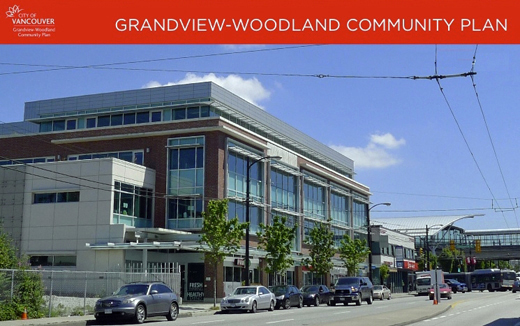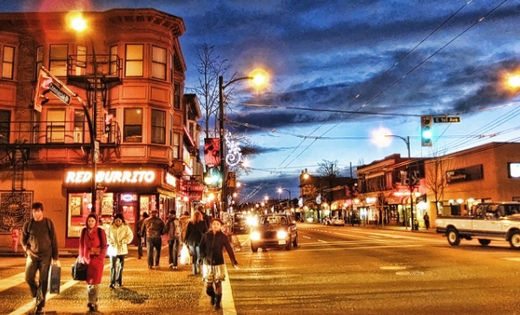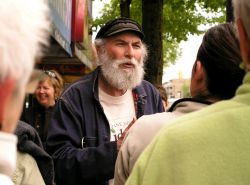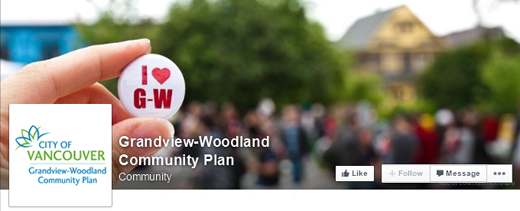
A couple of weeks back when arriving home from an afternoon all-candidates meeting, an old associate, decades-long City of Vancouver planner, and neighbour — knowing of my time on Vancouver’s Board of Variance, and my consuming interest in all things community planning — asked if he could speak with me for a few minutes about a concern he had respecting a recent community planning process gone awry.
The crux of the concern raised was this: the Grandview-Woodland Community Plan on which he and his City Hall colleagues had spent considerable time in consultation with residents on drafting and submitting to City Council, bore no relation to the finalized plan presented to Council.
Interference from the Mayor’s office, he suggested, as well as highly suspect and unilateral changes to the community plan had been made subsequent to the submission of the Grandview-Woodland Community Plan to the office of Vancouver’s recently-appointed General Manager of Planning and Development, Brian Jackson — including the addition of a mass of 26 – 40 storey towers at both Clark and Commercial Drives, along East Broadway, and mid-rise 8-storey multiple-unit residential buildings along the expanse of Nanaimo and Hastings Streets, neither of which was included in the original plan submitted to Jackson.
As per standard journalistic practice, VanRamblings set about to second-source the information provided to us above, when what should land in our e-mail inbox but a 1410-word Open Letter, titled Inside Story of a Botched Community Plan, written by housing, development and community activist Ned Jacobs, subtitled “How the Robertson administration has betrayed the public trust and is destroying community planning in Vancouver.”

The information contained in Jacobs’ letter, virtually word-for-word reflects the information that had been provided to me two weeks ago. Speaking with Jacobs on Monday afternoon, we discovered that his source was not the same senior city planning staffer who had earlier spoken to me.
Jacobs’ letter makes repeated reference to a Mayor Gregor Robertson / Dr. Penny Ballem (Vancouver City Manager) / Brian J. Jackson triumvirate who were involved in the drafting of, and inclusion in, a revised and substantively changed Grandview-Woodland Community Plan. In fact, according to the city planning official with whom VanRamblings spoke, Mike Magee, the Mayor’s Chief of Staff, as well as several Vision Vancouver City Councillors, played a pivotal role in the redrafting of the community plan that would finally be presented to Vancouver City Council.
Note should be made that at the Grandview-Woodland all-candidates meeting last week, incumbent City Councillor Andrea Reimer told the crowd in attendance that neither she, nor her Vision Vancouver Council colleagues were aware of the contents of the Grandview-Woodland Community Plan prior to its initial presentation to Council.
The response of the crowd to Reimer’s statement was jeers, while the response of her fellow all-candidate panelists was, at best, querulous.
Councillor Reimer also set about to assure the citizens who had gathered at Britannia Secondary School, that she felt quite certain the Citizens’ Assembly created as a “new tool in the city’s public-engagement toolbox,” when it reported out, would not recommend, nor agree to, the mass of towers along East Broadway, between Clark and Commercial Drives, that had caused so much consternation among Grandview-Woodland residents.
Again the audience jeered.
Clearly, the residents of Grandview-Woodland — as is the case in neighbouhoods across the city, ranging from Mount Pleasant on the eastside to Dunbar on the westside, through to the West End, Yaletown and False Creek North in the downtown core, not to mention, Marpole — are unbelieving of a Vision Vancouver civic administration where honest, thorough, citizen-engaged consultation has been in short supply.
Time and time again, under Vision Vancouver, the city has failed to adhere to best practices in neighbourhood planning, most often defined as …
- An opportunity to involve citizens in considering their future that provides effective tools for examining their community;
- Collaborative citizen involvement in neighbourhood planning and development, and …
- Neighbourhood planning that brings together multiple city departments, community organizations, citizens, business improvement associations and related community stakeholders, and social service providers, who working together would seek to co-ordinate their collective efforts to ensure the delivery of a wide range of quality services at the neighbourhood level, so as to provide a more responsive, interactive environment for residents to express their concerns and needs.
Generally, best practices neighbourhood planning involves a years-long process that encourages citizens, through workshops and task group meetings, to become involved in neighbourhood planning — not unlike Vancouver’s successful Gordon Campbell-Ann McAfee-inspired City Plan process of days gone by, a planning process that engaged all sectors of the community in what was most often a years-long effort that encouraged a broad range of citizens to become involved in their neighbourhood planning, a truly democratic and citizen-engaged community visioning process.
During the course of the present Vancouver civic election campaign, NPA mayoralty candidate Kirk LaPointe has talked about reinstating City Plan.
Vancouverites are well aware that with a Vision Vancouver administration at City Hall, and a development on speed ethos driving development across the city, that citizen-engaged neighbourhood planning processes in our city have become nothing more than a nostalgic, warily abused & hoary fiction.
![]()
![]()
![]()
![]()
![]()
![]()
![]()
![]()
![]()
Update: For further insight into the botched Grandview-Woodland Community Plan, it’s worth reading the commentary of Scot Hein — the City of Vancouver’s Senior Urban Designer at the time the Grandview-Woodland process was tabling built form — his team “… absolutely did not support towers outside the focused “Safeway Precinct,” he writes.
Here is Ned Jacobs’ Open Letter, posted to VanRamblings, and others …


Inside Story of a Botched Community Plan
How the Robertson administration has betrayed the public trust and is destroying community planning in Vancouver
Dear Concerned Citizens of Vancouver,
Recently, on the spur of the moment, I contacted an individual I have known for a number of years through their work for the City of Vancouver.
  |
Since the subject of my call was not directly related to their current activities, I called them at home. Our conversation drifted onto the topic of the suitability of various forms of development. Then suddenly, as if a dam was breaking, out spilled an account of how and why the Grandview-Woodland community planning process went off the rails and was put on hold by the Robertson–Vision Vancouver administration until after the civic election campaign now in progress.
At the end of our conversation I told this person that I felt obliged to pass on this important and disturbing information, and asked if they could be quoted. After a pause my informant requested anonymity, to which I agreed. I am certain that the information communicated to me by the person I shall call “my source” is fundamentally accurate, and that their sharing of it was not premeditated, but a spontaneous act of conscience.


In a nutshell, here is what happened: In 2012-13, during the process to update the Grandview-Woodland Community Plan, planners were assigned to produce a new land use plan for the area to be presented to the community for feedback and input prior to completion of a report and recommendations to City Council.
The planners created a proposal that was consistent with the city’s population targets for Grandview-Woodland, and which they thought would be favourably received by many members of the community. My source explained that the plan relied heavily on “invisible density”(an unfortunate term, because all development is of course visible). In essence the phrase means new types of development that are generally consistent with existing scale and respectful of neighbourhood character. For example, three storey rowhouses that don’t exceed “single-family” height limits, or four-storey apartments on streets that already allow similar buildings in shopping areas.
The proposal also included some midrise apartments along Broadway, and “just a bit of height at the Safeway site to encourage timely redevelopment.” But my source was adamant that this plan included “no towers”, which the planners thought were inappropriate for this neighbourhood, and would be rejected by the vast majority of residents.
The proposal was showed to Brian Jackson, the city’s Manager of Planning and Development. “He went ballistic.” Jackson “lambasted” the planners for not including any tall towers. “It was very ugly.” Then he ordered them to go back to the drawing board and produce a plan that packed in as many towers as was possible.
“Under protest” the planners complied, and brought back a plan containing 20 tall towers. Jackson showed this plan to Mayor Robertson and City Manager Ballem. They were pleased with the concept, but Robertson expressed some concern about “pushback” from the community heading into an election year. He suggested the number of towers be “dialed down.”
Jackson then directed the planners to reduce the number of towers by half. Again they complied, but once again “under protest”. This satisfied Jackson (and presumably Robertson and Ballem). The plan was released in a document titled Emerging Directions. My source commented that while they were developing these plans the planners “anticipated and prepared for FOI” (Freedom of Information) applications.
The public response in Grandview-Woodland was outrage, not only due to the towers, but because these “directions” had “emerged” from the planning offices without public involvement in the topics of new building types, density or scale, and because development options that did not utilize towers in the Broadway-Commercial area were not included.
What the public didn’t know is that the planners who had been studying the area and meeting with the community on a variety of topics had in fact done extensive work to produce the kinds of low and midrise options that residents were requesting, which the planners also favoured but had not been allowed to present to the community because of the secret directions from Robertson, Ballem and Jackson.
Although meaningful public involvement and influence in Vancouver planning decisions has been in steep decline since EcoDensity was approved by the NPA administration led by Sam Sullivan and Suzanne Anton, which Robertson and Vision replaced after the 2008 election, such extreme lack of public involvement in major land use change is unprecedented in Vancouver planning history.
In some parts of the city such public outrage might have been ignored, but in Grandview-Woodland it was feared that that backlash would have severe political ramifications because the area has been a Vision Vancouver electoral stronghold. Consequently, the administration postponed adoption of the plan and announced — again without public input — that they would set up a Citizens’ Assembly of selected volunteers to ensure representative public engagement, a model the administration says they will use for future planning processes throughout Vancouver. (Dr. Wendy Sarkissian, an Australia-based planner and internationally recognized authority on public engagement, who also teaches in Vancouver at UBC and VCC, has criticized the Citizens’ Assembly model as inappropriate for this situation).
My source characterized the Citizens’ Assembly as “a PR exercise” and said they saw nothing to indicate that the administration is willing over the long run to drop plans for towers in Grandview-Woodlands.
My source then explained why they think this administration is so hung up on towers, even though similar densities can be achieved with ground-oriented forms that respect human scale, promote neighbourliness, preserve public views and access to sun and sky, and are better received by residents in most Vancouver neighbourhoods.
I was told that Jackson is “fixated” on towers, to the neglect of other building forms. My source also said that Jackson is not well respected by most of the planners working under him because of his frequent disregard for “best practices.”
Jackson’s fondness for towers was one of the main reasons he was hired to replace former Planning Director Brent Toderian, who also likes towers, but not to the same extent. Toderian’s reluctance to recommend towers on certain sites because of livability and urban design considerations was a major factor in his being fired “without cause” following the 2011 election. According to my source, and others I have talked to, Toderian’s discomfort with unprecedented political interference by the Vision Vancouver-run administration was a related factor in his departure.
But Jackson was a good fit for this administration, which is similarly fixated on towers. My source explained that this is because most big-time developers are demanding towers, largely because of the availability of foreign capital for investment in this form, but not in low and midrise multi-family housing. Robertson and his advisors are hoping that eventually this offshore interest in Vancouver real estate will lead to foreign business investment. Meanwhile, major up-zonings and development policies that call for towers is feeding land speculation that contributes to making Vancouver even less affordable, despite increases in the housing supply.
Another cause for the tower fixation, explained my source, is this administration’s “addiction” to obtaining revenue from development, which is most easily accomplished through towers. But like other addictions, this one is subject to the law of diminishing returns. As land prices balloon in expectation of major redevelopment opportunities, the value the city can capture for public benefits and non-market housing from “land lift” (increased value due to more intensive use) is shrinking.
There is nothing to indicate that the current administration’s addiction to towers and developer political patronage is abating. My source spoke of towers all along Broadway to UBC. Real estate interests — not sound transportation policy — is the driving force behind Robertson’s fiscally irresponsible call for a subway from Central Broadway to the campus, which can only be accomplished by depriving the rest of the city (and region) of much-needed transit improvements, and by using the city’s share of proceeds from scores of new residential towers in the West Broadway corridor to help fund a subway, while public amenities and non-market housing are neglected.
My serendipitous discussion with this inside source confirmed what many have been saying: that the Robertson administration has badly lost its way and is unwilling to re-evaluate their development policies and strategies, or be upfront about their motives, substituting public relations campaigns for meaningful collaboration with the Vancouver public.
Sincerely,
Ned Jacobs
November 2, 2014